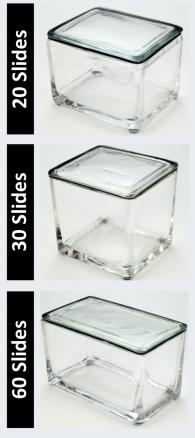Alcian Blue/PAS Stain Kit
Differentiates between acidic epithelial mucins (sialomucin, sulfomucin) and neutral epithelial mucin and is a means of detecting the overall presence of mucins. Acidic mucins are stained with the Alcian Blue technique while neutral mucins and glycogen are stained by the PAS reaction.
ALCIAN BLUE/PAS STAIN KIT INCLUDES:
| Part 91022A | Part 91022B | ||
| Solution A: | Acetic Acid 3%, Aqueous | 250 ml | 500 ml |
| Solution B: | Alcian Blue Stain 1%, pH 2.5, Aqueous | 250 ml | 500 ml |
| Solution C: | Periodic Acid 0.5%, Aqueous | 250 ml | 500 ml |
| Solution D: | Schiff Reagent, McManus | 250 ml | 500 ml |
| Solution E: | Hematoxylin Stain, Mayer Modified | 250 ml | 500 ml |
COMPLIMENTARY POSITIVE CONTROL SLIDES: Enclosed are two complimentary unstained positive control slides for the initial verification of staining techniques and reagents. Verification must be documented by running one Newcomer Supply complimentary positive control slide along with your current positive control slide for the first run. Retain the second complimentary control slide for further troubleshooting, if needed.
Individual stain solutions and additional control slides may be available for purchase under separate part numbers.
Additionally Needed:
| Xylene, ACS | Part 1445 |
| Alcohol, Ethyl Denatured, 100% | Part 10841 |
| Alcohol, Ethyl Denatured, 95% | Part 10842 |
For storage requirements and expiration date refer to individual bottle labels.
APPLICATION:
Newcomer Supply Alcian Blue/PAS Stain Kit procedure is used to differentiate acidic epithelial mucins (sialomucin, sulfomucin), neutral epithelial mucins and stromal (mesenchymal) mucins and is a means of detecting the overall presence of mucins.
METHOD:
Fixation: Formalin 10%, Phosphate Buffered (Part 1090)
Technique: Paraffin sections cut at 4 microns
Solutions: All solutions are manufactured by Newcomer Supply, Inc.
All Newcomer Supply Stain Kits are designed to be used with Coplin jars filled to 40 ml following the staining procedure provided below. Some solutions in the kit may contain extra volumes.
STAINING PROCEDURE:
-
- If necessary, heat dry tissue sections/slides in oven.
- Deparaffinize sections thoroughly in three changes of xylene, 3 minutes each. Hydrate through two changes each of 100% and 95% ethyl alcohols, 10 dips each. Wash well with distilled water.
-
- See Procedure Notes #1 and #2.
-
- Place slides in Solution A: Acetic Acid 3%, Aqueous for 3 minutes.
- Place slides directly into Solution B: Alcian Blue Stain 1%, pH 2.5, Aqueous for 15 minutes.
- Wash slides gently running tap water 1-2 minutes; rinse in distilled water.
- Place in Solution C: Periodic Acid 0.5%, Aqueous for 5 minutes.
- Wash in running tap water for 1-2 minutes; rinse in distilled water.
- Place in Solution D: Schiff Reagent, McManus for 10 minutes.
- Wash in lukewarm tap water for 5-10 minutes.
- Stain lightly in Solution E: Hematoxylin Stain, Mayer Modified for 1 minute.
- Rinse in running tap water for 1-2 minutes.
- Dehydrate in two changes each of 95% and 100% ethyl alcohol. Clear in three changes of xylene, 10 dips each; coverslip with compatible mounting medium.
RESULTS:
| Acid epithelial mucin | Violet |
| Neutral epithelial mucin | Magenta |
| Glycogen | Magenta |
| Stromal (mesenchymal) mucin | Blue |
| Nuclei | Pale blue |
PROCEDURE NOTES:
-
- Drain slides after each step to prevent solution carry over.
- Do not allow sections to dry out at any point during procedure.
- If using a xylene substitute, closely follow the manufacturer’s recommendations for deparaffinization and clearing steps.
REFERENCES:
-
- Bancroft, John D., and Marilyn Gamble. Theory and Practice of Histological Techniques. 6th ed. Oxford: Churchill Livingstone Elsevier, 2008. 173-174.
- Carson, Freida L., and Christa Hladik Cappellano. Histotechnology: A Self-instructional Text. 4th ed. Chicago: ASCP Press, 2015. 150-151.
- Modifications developed by Newcomer Supply Laboratory






